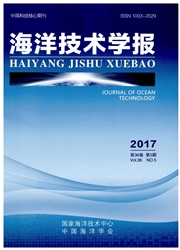

 中文摘要:
中文摘要:
目前,几乎所有关于海底管道屈曲传播和止屈器的研究都是基于准静态的情况下进行的,文中对在更加真实的动态恒定载荷下海底管道屈曲传播和整体式止屈器的止屈效果进行评估。通过非线性有限元分析软件ABAQUS建立整体式止屈器的准静态和动态模型,基于有限元变形运动学,对管道屈曲压溃后的接触问题进行适当设定。有限元模型较精确地模拟了管道屈曲的稳定传播和止屈,结果观察到了整体式止屈器的动态加强现象,通过有限元数值模拟与美国的动态试验结果对比分析数据。此外,通过研究速度与压力关系,发现管道屈曲剖面减短和屈曲前方管道反向椭圆度随压力变化的规律,分析了止屈器动态加强的机理。研究表明,目前整体式止屈器的准静态设计过于保守,今后设计时应考虑更为实际的动态环境载荷。
 英文摘要:
英文摘要:
Based on experiments and analyses in which buckles propagated and engaged the arrestors quasi-statically, the performances of propagating buckle and integral buckle arrestors in pipelines were reevaluated under the more realistic dynamic buckle propagation conditions encountered in the sea. The models for simulating the quasi-static and dynamic propagation and arrest of buckles in pipelines were presented, which were developed within the framework of the nonlinear finite element ABAQUS. Based on finite deformation kinematics, the contact developed in the collapsed tube behind the propagating buckle was properly treated. The dynamic model was shown to reproduce accurately the conditions of steady-state buckle propagation as well as the dynamic engagement of a buckle with an arrestor. For all cases considered, the dynamic enhancement of arrestor performance was observed as in the experiments. For buckle velocities of interes4 the buckle profile was found to have sharpened considerably compared to the quasi-static one, which cause significant reverse ovality in the tube in front of the buckle and in the downstream tube. Based on the result of this study, it is concluded that quasi-static design procedures for integral buckle arrestors proposed previously are conservative.
 同期刊论文项目
同期刊论文项目
 同项目期刊论文
同项目期刊论文
 Two-phase flow numerical simulation of a bend-type ice sluice in the diversion water channel of powe
Two-phase flow numerical simulation of a bend-type ice sluice in the diversion water channel of powe Experimental study on the bed topography evolution in alluvial meandering rivers with various sinuou
Experimental study on the bed topography evolution in alluvial meandering rivers with various sinuou Analysis of agricultural pollution by flood flow impact on water quality in a reservoir using a thre
Analysis of agricultural pollution by flood flow impact on water quality in a reservoir using a thre Three-dimensional simulation of the water flow field and the suspended-solids concentration in a cir
Three-dimensional simulation of the water flow field and the suspended-solids concentration in a cir Numerical investigation on vortex-induced vibration of an elastically mounted circular cylinder at l
Numerical investigation on vortex-induced vibration of an elastically mounted circular cylinder at l An Integrated Groundwater Management Mode Based on Control Indexes of Groundwater Quantity and Level
An Integrated Groundwater Management Mode Based on Control Indexes of Groundwater Quantity and Level Short-term optimal operation of Three-gorge and Gezhouba cascade hydropower stations in non-flood se
Short-term optimal operation of Three-gorge and Gezhouba cascade hydropower stations in non-flood se Risk identification on hydropower project using the IAHP and extension of TOPSIS methods under inter
Risk identification on hydropower project using the IAHP and extension of TOPSIS methods under inter The effects of strong motion duration on the dynamic response and accumulated damage of concrete gra
The effects of strong motion duration on the dynamic response and accumulated damage of concrete gra Observation of microscopic damage accumulation in brittle solids subjected to dynamic compressive lo
Observation of microscopic damage accumulation in brittle solids subjected to dynamic compressive lo Laboratory observation of acoustic fluidization in granular fault gouge and implications for dynamic
Laboratory observation of acoustic fluidization in granular fault gouge and implications for dynamic Laboratory measurements of the rate dependence of the fracture toughness anisotropy of Barre granite
Laboratory measurements of the rate dependence of the fracture toughness anisotropy of Barre granite Optimal sensor placement for large structures using the nearest neighbour index and a hybrid swarm i
Optimal sensor placement for large structures using the nearest neighbour index and a hybrid swarm i Joint impact of rainfall and tidal level on flood risk in a coastal city with a complex river networ
Joint impact of rainfall and tidal level on flood risk in a coastal city with a complex river networ Eulerian-Eulerian solid-liquid two-phase flow of sandstone wastewater in a hydropower station rectan
Eulerian-Eulerian solid-liquid two-phase flow of sandstone wastewater in a hydropower station rectan Research on virtual-reality interactive simulation for concrete dam construction process based on ve
Research on virtual-reality interactive simulation for concrete dam construction process based on ve Seismic cracking analysis of concrete gravity dams with initial cracks using the extended finite ele
Seismic cracking analysis of concrete gravity dams with initial cracks using the extended finite ele Constructioin Schedule Real-time Control Coupling Consruction Quality in Large Scale Underground Pow
Constructioin Schedule Real-time Control Coupling Consruction Quality in Large Scale Underground Pow Comprehensive Evaluation of the Coupling Construction Progress and Quality of High Core Rockfill Dam
Comprehensive Evaluation of the Coupling Construction Progress and Quality of High Core Rockfill Dam Joint probability distribution of winds and waves from wave simulation of 20 years (1989-2008) in Bo
Joint probability distribution of winds and waves from wave simulation of 20 years (1989-2008) in Bo Construction Schedules Simulation and Prediction of Water Conveyance Tunnel Based on Karst Geologica
Construction Schedules Simulation and Prediction of Water Conveyance Tunnel Based on Karst Geologica Research on Management Information System for Construction Consultant in Hydropower Project Based on
Research on Management Information System for Construction Consultant in Hydropower Project Based on A Study on the Controllability of Deepwater Manifold during Launch through Pendulous Installation Me
A Study on the Controllability of Deepwater Manifold during Launch through Pendulous Installation Me Research on Construction Schedule Real-Time Control of High Core Rock-Fill Dam Based on Digital Moni
Research on Construction Schedule Real-Time Control of High Core Rock-Fill Dam Based on Digital Moni Tracking methods for free surface and simulation of a liquid droplet impacting on a solid surface ba
Tracking methods for free surface and simulation of a liquid droplet impacting on a solid surface ba Finite element analysis on thermal upheaval buckling of submarine burial pipelines with initial impe
Finite element analysis on thermal upheaval buckling of submarine burial pipelines with initial impe 期刊信息
期刊信息
